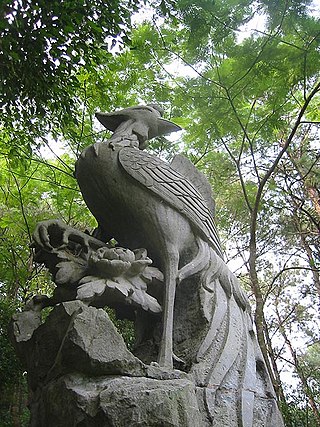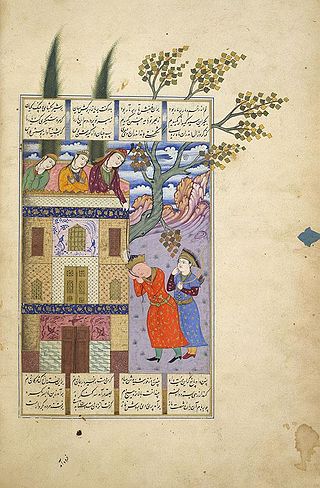Related Research Articles

Fènghuáng are mythological birds found in Sinospheric mythology that reign over all other birds. The males were originally called fèng and the females huáng, but this distinction of gender is often no longer made and they are blurred into a single feminine entity so that the bird can be paired with the Chinese dragon, which is traditionally deemed male.

The Turul is a mythological bird of prey, mostly depicted as a falcon, in Hungarian tradition and Turkic tradition, and a national symbol of Hungarians.
Chamrosh is a bird in Persian mythology said to live on the summit of Mount Alborz.

The simurgh is a benevolent bird in Persian mythology and literature. It bears some similarities with mythological birds from different origins, such as the phoenix and the humā. The figure can be found in all periods of Iranian art and literature and is also evident in the iconography of Georgia, medieval Armenia, the Eastern Roman Empire, and other regions that were within the realm of Persian cultural influence.

The world tree is a motif present in several religions and mythologies, particularly Indo-European, Siberian, and Native American religions. The world tree is represented as a colossal tree which supports the heavens, thereby connecting the heavens, the terrestrial world, and, through its roots, the underworld. It may also be strongly connected to the motif of the tree of life, but it is the source of wisdom of the ages.
Iranian mythology, or Persian mythology in western term, is the body of the myths originally told by ancient Persians and other Iranian peoples and a genre of ancient Persian folklore. These stories concern the origin and nature of the world, the lives and activities of deities, heroes, and mythological creatures, and the origins and significance of the ancient Persians' own cult and ritual practices. Modern scholars study the myths to shed light on the religious and political institutions of not only Iran but of the Persosphere, which includes regions of West Asia, Central Asia, South Asia, and Transcaucasia where the culture of Iran has had significant influence. Historically, these were regions long ruled by dynasties of various Iranian empires, that incorporated considerable aspects of Persian culture through extensive contact with them, or where sufficient Iranian peoples settled to still maintain communities who patronize their respective cultures. It roughly corresponds to the Iranian Plateau and its bordering plains.

In Slavic mythology and folklore, the Firebird is a magical and prophetic glowing or burning bird from a faraway land which is both a blessing and a harbinger of doom to its captor.

Zāl, alternatively spelled as Zaal, is a legendary Iranian king from Sistan, and is recognized as one of the greatest warriors of the Shahnameh epic. He is the father of the equally legendary Iranian hero, Rostam.

Esfandiyār or Espandiyār is a legendary Iranian hero and one of the characters of Ferdowsi's Shahnameh. He was the son and the crown prince of the Kayanian King Goshtasp and Queen Katāyoun. He was the grandchild of Kay Lohrasp.

The Huma, also Homa, is a mythical bird of Iranian legends and fables, and continuing as a common motif in Sufi and Diwan poetry. Although there are many legends of the creature, common to all is that the bird is said never to alight on the ground, and instead to live its entire life flying invisibly high above the earth.
Prâslea the Brave and the Golden Apples is a Romanian fairy tale collected by Petre Ispirescu in Legende sau basmele românilor.
In Turkic folklore, Korbolko is a firebird. He brought fire to earth and taught the people to burn the fire.

Div or dev are monstrous creatures within Middle Eastern lore, and probably Persian origin. Most of their depictions derive from Persian mythology, integrated to Islam and spread to surrounding cultures including Armenia, Turkic countries and Albania. Despite their Persian origins, they have been adapted according to the beliefs of Islamic concepts of otherworldly entities. Although they are not explicitly mentioned within canonical Islamic scriptures, their existence was well accepted by most Muslims just like that of other supernatural creatures. They exist along with jinn, peri (fairies) and shayatin (devils) within South and Central Asian demon-beliefs.

Anqa, also spelled 'Anqa' , or Anka, or Anqa Mughrib or Anqa al-Mughrib, is a golden mysterious or fabulous female bird in Arabian mythology. She is said to fly far away and only appear once in ages. However, it is also said that she can be found at "the place of the setting of the sun".
Leaves of Pearls is an Iranian folktale first collected and published by author Saiyed Abolqasem Angavi Shirazi. It deals with a prince and his brothers sent on a quest to find a remedy for their father.
References
- 1 2 Juan Eduardo Cirlot, A Dictionary of Symbols, Courier Dover Publications, 2002, p.253
- ↑ P Donabedian and J. M. Thierry, Armenian Art, New York, 1989, p. 488.
- ↑ Thierry, N. and M., Nouvelles églises rupestres de Cappadoce, Paris, 1963, p. 84-85.
- ↑ Der Artikel in the Encyclopedia of Bashkortostan
- ↑ Hanns-Peter Schmidt, Encyclopedia Iranica - "Simorgh".